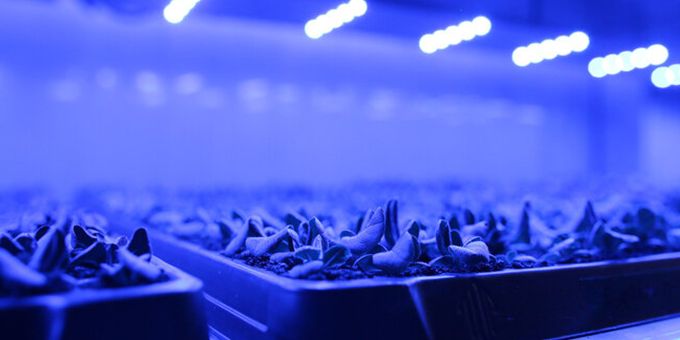While most of us think that growing crops involves planting seeds, there’s actually another way...cloning! Cloning might sound like a complicated process involving mad scientists, but it’s actually quite simple.
 Plant Cloning: 4 Easy Steps to Get Started
Plant Cloning: 4 Easy Steps to Get Started

Rebecca Shamritsky | Freight Farms
There are a few ways that you can create a plant clone, but the simplest is to make a plant “cutting”. This is a process of taking part of a healthy plant, replanting it, and having it grow. Since cloning is a form of asexual plant reproduction–meaning only one ‘set’ of DNA–the resulting clones are an exact replica of the parent plant.
BENEFITS OF PLANT CLONING
Simply put, cloning is the surest way to replicate successful plants. By developing plant clones, you can recreate all the desired characteristics of the parent plant over and over again. This is particularly beneficial for growing plants commercially since it ensures consistency generation after generation.
WHICH ARE THE BEST PLANTS TO CLONE?
Herb clones traditionally perform really well– some varieties to try include thyme, sage, basil, and mint (the subject of our video!). While you can theoretically clone any plant, the main school of thought is that plants with sturdier/thicker stems (like a tomato plant) will be more successful while a stalk-less, flimsy, or soft plant (like lettuce) will not clone well at all.
Another thing to think about when deciding what to clone is whether the plant is a dicot or a monocot. A dicot is a plant that develops different branches (like an herb, chard, vine plant, etc.) while a monocot has one single stalk (asparagus, corn, onions, etc.). For cloning, dicots would be more successful since there are branches that you can cut and clone while keeping the original plant intact.
WHAT IS A ROOTING HORMONE?
A rooting hormone is a substance that helps new roots develop and is essential for successful cloning. The main hormone that a plant produces naturally to develop roots is auxin. However, this hormone is not used efficiently by the plant during clone cultivation since it is broken down quickly when exposed to light.
This is why, when cloning plants for commercial production, it’s highly recommended to use a synthetic rooting hormone. The synthetic hormone replicates the natural rooting process in all of your newly cut plants and helps to develop a strong root system.
You can find many types of rooting hormones in stores and online. Here at Freight Farms, we swear by Garden Safe - Take Root.
Plant Cloning in 4 Easy Steps
Before you begin…
In order to clone your plant successfully, you need:
-
A healthy plant that you want to clone
-
A rooting hormone, like Garden Safe - Take Root
-
Empty seedling trays and enough grow plugs
-
Scissors or clippers
Step 1: Cut the right plant the right way
With cloning, what matters most is cutting from the right part of the plant. You can choose to cut the tip of the stem or the middle of the stem. If you’re not sure, we recommend cutting the tip of the stem since that’s where most of the plant growth is happening already.
However, cutting the middle can be equally effective, especially if the plant you’re working with is showing new leaf buds along the stem. Cutting directly above those baby leaves will actually produce two separate shoots when the plant begins to regrow as a clone. This is a great option if you’re looking to grow a bushier plant.
Regardless of which option you choose, you want to work with a plant that has a thick and sturdy stem. The section you choose (middle or tip) should also have four visible leaves. Being selective in this way will give your clones the best chance: propagation is an energetically expensive process, so starting with a hearty plant increases the likelihood of success.
Step 2 - Cut the leaves and stems at an angle
After you’ve clipped the cutting from your mature plant, you need to cut all the fully-developed leaves and the stem at an angle.
Cutting the leaves at an angle will encourage the plant to send its energy down into the roots instead of spending energy on growing leaves (that comes later!). When we do this step, we usually cut about 50% of the leaf off.
Cutting the stem at an angle creates more surface area for the rooting hormone, which will eventually lead to more root growth.
Step 3 - Add the rooting hormone and re-plant
As we prepare to add the rooting hormone powder, keep in mind that you’ll be most successful if you add the powder immediately after cutting the stem, since a freshly cut stem has more moisture and will therefore pick up more of the powdered hormone. From a workflow perspective, this means you should cut-and-dip, versus waiting to add the hormone until after all your cuttings are done.
When you’re ready to add the hormone powder, tap some out into a shallow dish (the lid of the jar works perfectly too). Tap the just-trimmed end of the plant in the powder until there’s a thick and even layer sticking to the bottom of the stem.
Once the hormone is on the plant, simply stick the end into a new grow plug and place the grow plug into an available seedling tray.
Repeat this until you have all your clones ready in the seedling tray(s).
Step 4 - Watch your clones grow!
Just like with typical seedlings, the clones will need to be covered with a humidity dome. However, unlike plants growing from seeds, they will need access to water the whole time, so you will keep your normal watering schedule. Another difference is that seedlings growing from seed typically stay in the nursery station for three weeks, while the clones will take a little bit longer. At three weeks, the clones finish developing their new root structure, so they need another 1-2 weeks to grow their stems and leaves before moving to the cultivation area.
The content & opinions in this article are the author’s and do not necessarily represent the views of AgriTechTomorrow
Comments (0)
This post does not have any comments. Be the first to leave a comment below.
Featured Product


